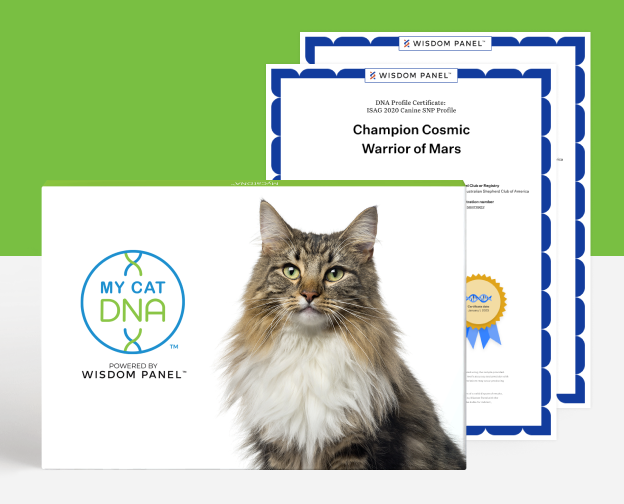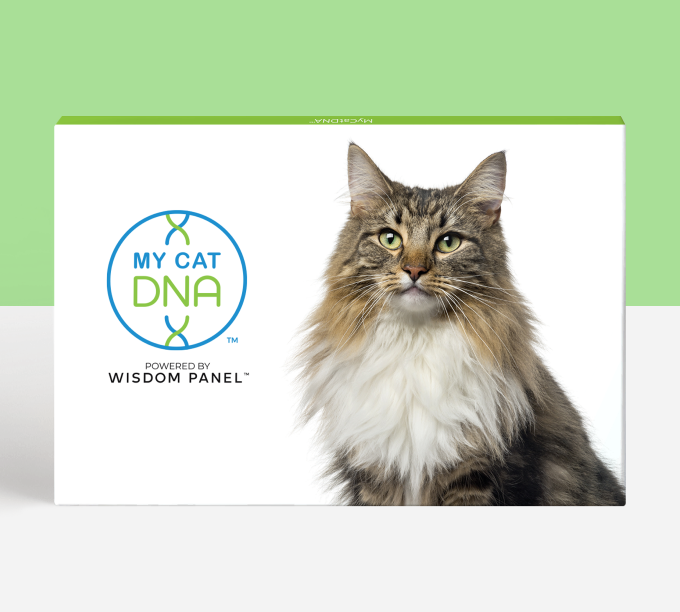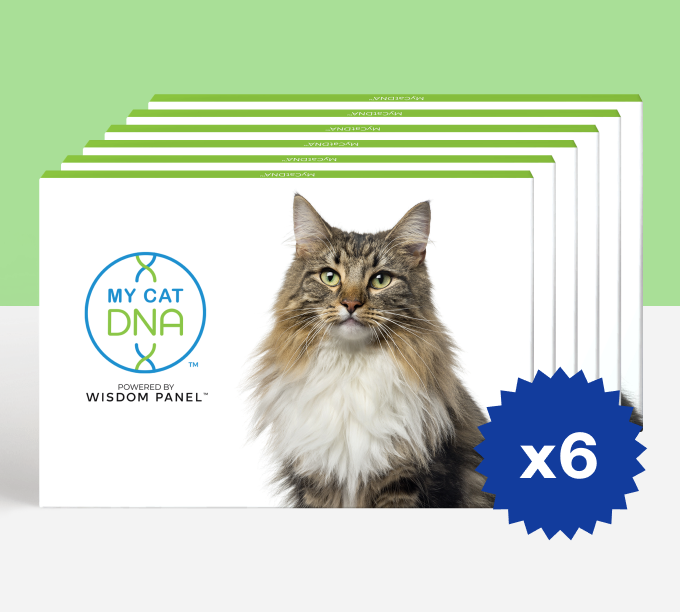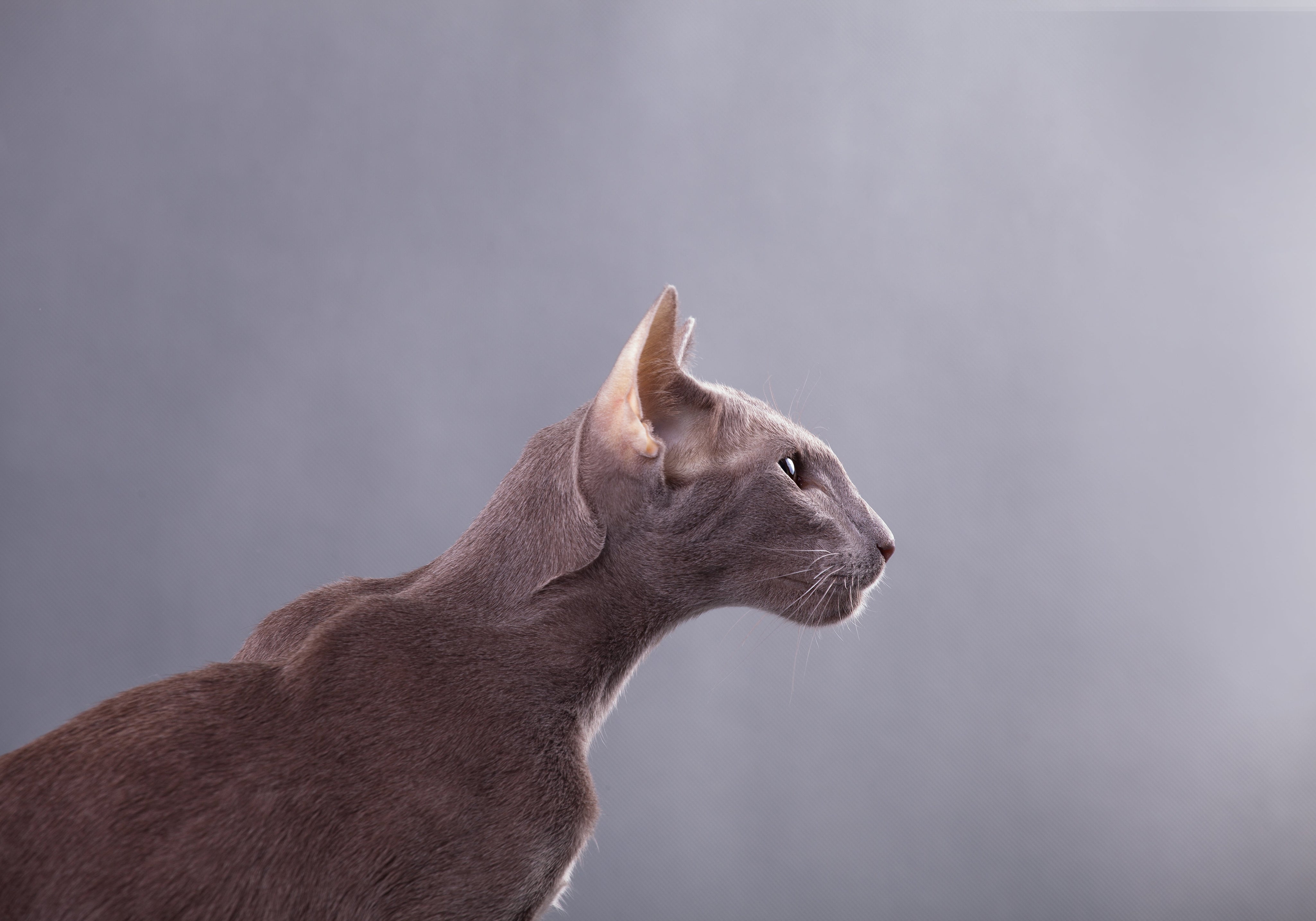Many beautiful pattern varieties in pedigreed cats with names like shaded, chinchilla, smoke or shell are all attributed to the activity of the Agouti gene. Tabbies, whether blotched/classic, mackerel, spotted or ticked, are known to have colour-banded hairs, with an apical tip of dark pigment, followed by a variable number of bands of dark and reddish pigment, ending with reddish pigment. Dark pigments could be black, chocolate, blue or lilac, and as a family are called eumelanins or “true” melanins. Red, yellow, and cream hues belong to the other main pigment family called “phaeomelanins.” An area of significant research in the last 5+ years have been around the so-called Agouti modifiers, specifically Wideband genes, which modify the colour banding of the hairs.

Tag Team: Agouti & Wideband
A pattern called Agouti or tabby describes a coat of banded hairs of eumelanin and phaeomelanin, always starting with a phaeomelanin root, and ending with a eumelanin tip, with no particular colour predominating, leading to the appearance of brown coloration. However, many breeds exhibit a disruption to this banding, earning many names depending on the length of the apical dark pigment tip:
- Chinchilla, tipped, or shell: dark pigment occupies 1/5-1/8 of the hair, only at the tip
- Shaded: dark pigment occupies ¼ of the hair, only at the tip
- Smoke: dark pigment occupies ½ of the hair, only on the upper half
What causes this variable banding? Three genes are known to play a role: the Agouti gene, ASIP, the Extension gene, MC1R, and the relatively newly-discovered Wideband gene, CORIN.
The MC1 Receptor (MC1R)
MC1R you might recognize as the gene responsible for Russet in the Burmese, Amber in the Norwegian Forest Cat, or Copal in the Kurilian Bobtail, all reddish coat patterns. These are different than common Orange, which is sex-linked. MC1R is also called the Extension locus (E locus) because it can extend the amount of red or phaeomelanin expressed in the coat. The MC1-receptor is located only in pigment-producing cells, and in this case, we are interested in the ones located in the hair follicle, where all the coat-colour magic happens. If the MC1-receptor doesn't have a mutation, it can bind to different proteins: Melanocyte Stimulating Hormone (MSH), which encourages dark pigment production, and the Agouti gene ASIP (A locus) protein, which blocks the activity of MC1R, switching on reddish pigment production. MSH is by default active at the beginning of the hair growth cycle, and Agouti proteins typically peak shortly after start of hair growth, to produce a subapical band of reddish pigment. These two proteins can alternatively bind the MC1-receptor throughout the hair growth cycle, resulting in banded hairs.
CORIN: A Wideband Gene
Agouti is the switch from dark to red pigments, and CORIN was discovered to be responsible for the switch from red to dark pigment. So defects in the CORIN gene result in prolonged production of reddish pigment with delayed or no switch back to dark pigment. This pattern is described as wideband, referring to the wider band of reddish pigment. Since there is usually an initial phase of MSH activity at the beginning of hair growth, the apical tip of dark pigment is sometimes all that’s produced. The degree of CORIN dysfunction helps determine whether the cat is tipped or shaded, and shifts the colour spectrum from a balance of dark and red pigments to a lot more phaeomelanin. Five variants in the CORIN gene have now been discovered in felids, resulting in slightly different coat patterns.

CORIN in wild animals
In 2008, CORIN was first described as influencing pelage or coat colour in mice via modification of Agouti, resulting in what was called a “dirty blonde” phenotype. Previous to this time, research had focused on CORIN’s role in hypertension and cardiovascular disease, as it has effects on receptors elsewhere in the body. In 2017 it was then discovered that a second CORIN mutation was responsible for strawberry tabby or golden tabby Bengal tigers in captivity, opening the door for feline researchers to begin researching certain similar coat patterns found in domestic cats.

CORIN Mutations: Sunshine
Led by the University of Lyon and Antagene in France, researchers found in 2021 that a very similar pattern to that of the ‘golden tabby’ tigers was the cause of the rare colour called sunshine tabby in the Siberian cat breed. Sunshine phenotype was described by the researchers as:
“A warm tone of tabby, a pink nose lacking the black lining and a large light cream area around the nose.” (Beauvois 2021)
This finally linked a gene with the long-discussed wideband appearance in pedigreed cats, so they dubbed this new allele wb^SIB. The gene appeared to be inherited in a simple recessive pattern, and is not evident in solid cats, as it influences cyclic Agouti signaling not present in solid (a/a) cats. A scan of the 99 Lives Project found a few Kurilian Bobtails and ToyBobs that also carried the variant. All three breeds have Russian origins.
CORIN Mutations: Extreme Sunshine
One of the researchers, Dr. Marie Abitbol, then followed up in 2022 with a second study in Siberians, attempting to explain why some of the sunshine or sunshine silver cats did not appear to be homozygous (carrying two copies) for sunshine. She reported that a second CORIN variant had been found, also recessive, but dominant to wb^SIB, so cats with one copy of this new variant and one of sunshine would appear lighter in appearance:
“[Extreme-sunshine cats exhibit an] apricot to blond tone, shading of tabby marks, marked light-cream belly ...black paw pads and tail tip and the pink nose without a black line.” (Abitbol 2022)
For both variants of sunshine, paw pads remain a normal dark pigmented colour, unlike white spotting. This new variant was called wb^eSIB, with a proposed order of dominance of:
Wb^+ > wb^eSIB > wb^SIB

CORIN Mutations: Copper
Later that year, Dr. Abitbol published a third study on CORIN, this time in what were called “Golden shaded” British Shorthairs (BSH) coming out of Russia and Germany. Alternative names included copper, akita (after the urajiro pattern seen in certain Japanese breeds), light gold, extreme golden, flaxen gold, or British sunshine. A study of pedigree suggested another simple recessive gene, and she found it, again in CORIN. Colouration is similar to the sunshine Siberians:
“A ‘copper’ phenotype characterized by a red mantle with marked ivory belly and ivory spots on the upper sides of the paws.” (Abitbol 2022)
Given the striking hue of the cats, the colour was officially dubbed “copper” although the WCF recognizes these cats as “Flaxen Gold” and TICA still registers them as “Golden Shaded.” They also have normal dark-pigmented paw pads and will often have dark tipping on the tail and ears. The allele is referred to as wb^BSH or cop (copper).
CORIN Mutations: Sorrel
Longtime cat researchers Drs. Greg Barsh and Chris Kaelin also discovered in their Bengal cat research in 2024 that Bengals also have unique CORIN and MC1R mutations, and they believe the CORIN variants derive from the Asian Leopard Cat (Prionailurus bengalensis). They called the CORIN mutations Corin^lc, to distinguish them from the Corin^dom or the common domestic cat variant, and although the causal mutations were not found, they did find markers that appear to be closely linked. These variants, along with variants in MC1R, are thought to be responsible for the rufousing seen in some Bengals. They classified phaeomelanin intensity into five categories, with the CORIN and MC1R variants falling primarily into the category of cats with warm, rather than cool, red tones to the coat. These cats also tended to have pink noses, with more dark pigment retention in the leg bars and tail tip than in the body of the coat. Around 9 different CORIN mutations are suspected in the Bengal.
Communicating CORIN variants: a common language
What should we call these beautiful colors? There is a significant amount of variation in how these cats are labeled, with WCF calling them “Flaxen Golden,” TICA continuing to refer to them as “Golden Shaded,” and the Fédération Internationale Féline (FIFe) has just added a code for CORIN mutations as of January 2025, “u.” FIFe’s Easy Mind System (EMS) code “u” can now be used for CORIN mutants as a “non-recognized variety x,” now under a section for Silver, Corin and Golden, with restrictions:
-
Only labeled if “genetically proven to be CORIN”
-
Only for agouti varieties shaded, shell, or tabby (11, 12, 21-25)
-
Only in British Shorthair, British Longhair, Kurilian Bobtail, Siberian or Neva Masquerade
-
Can be used in conjunction with silver code (s)
-
Not used in conjunction with red or cream codes (d, e)
As copper, sunshine, and extreme sunshine are unique to British Shorthairs, Siberians, Kurilian Bobtails and Toybobs respectively, Wisdom Panel™ will refer to them as those colours for the purposes of clarity, as not all golden shaded cats are explained by current CORIN genes.
What we don’t know yet: Golden, Silver, Lightening
Are all Golden Shaded BSHs CORIN mutants? The short answer is that we don’t entirely know. Golden may be a separate locus or several genes, but it’s currently conceptualized as a single locus. Wisdom Panel™ has sequenced golden shaded British Shorthairs that did not carry any known CORIN variants, and the sorrel-coloured Bengal is thought to represent yet another CORIN variant, so it is likely there are additional CORIN variants yet to be discovered.
Are all wideband traits explained by CORIN variants? Again, this is unknown, but is also unlikely, as even within sunshine or copper cats, there is variation in phenotype. For example, Dr. Abitbol is researching a trait called “lightening” which has been proposed as a modifier to CORIN expression, lightening the color of the coat.
What about tabby coherence, chaos and Agouti Distribution? Although for simplicity most breeders will just represent Agouti distribution/chaos as Ad or U, most geneticists believe there are likely a number of genes that control the crispness of tabby patterns, with muted patterns dominant to crisp ones, in addition to wideband tabby modifiers like CORIN.
Geneticists already know that the dominant silver or inhibitor gene is at a different location than CORIN, so silver sunshine or silver copper phenotypes do occur. These cats are called “bimetallic” after the combined names and appearance. Some breeders have reported that their silver copper BSH toms actually change to a lighter colour during breeding season, and have suggested that silver and copper may interact.
Sunshine, Extreme Sunshine, and Copper are beautiful coat colours and patterns seen in a select few breeds of cats, but we will likely see more wideband research in the coming years to help breeders untangle the complex coat appearances seen across pedigreed breeds. CORIN variants and tabby modifiers are not currently available in MyCatDNA and Optimal Selection™ Feline, but will likely become available in 2026 as part of our commitment to comprehensive trait testing for feline breeders.
References:
Enshell-Seijffers D, Lindon C, Morgan BA. The serine protease Corin is a novel modifier of the Agouti pathway. Development. 2008 Jan;135(2):217-25. doi: 10.1242/dev.011031. Epub 2007 Dec 5. PMID: 18057101; PMCID: PMC2186067.
Xu, X., Dong, GX., Schmidt-Küntzel, A. et al. The genetics of tiger pelage color variations. Cell Research (27) 2017; 954–957. doi: 10.1038/cr.2017.32
Beauvois H, Dufaure de Citres C, Gache V, Abitbol M. Siberian cats help in solving part of the mystery surrounding golden cats. Anim Genet. 2021 Aug;52(4):482-491. doi: 10.1111/age.13076. Epub 2021 May 10. PMID: 33970502.
Abitbol M, Dargar T, Gache V. Golden cats: The story goes on. Anim Genet. 2022 Aug;53(4):543-545. doi: 10.1111/age.13215. Epub 2022 May 16. PMID: 35574714.
Abitbol M, Dargar T, Gache V. Golden cats: A never-ending story! Anim Genet. 2022 Oct;53(5):715-718. doi: 10.1111/age.13228. Epub 2022 Jun 15. PMID: 35703390; PMCID: PMC9544971.
Kaelin CB, McGowan KA, Hutcherson AD, Delay JM, Li JH, Kiener S, Jagannathan V, Leeb T, Murphy WJ, Barsh GS. Ancestry dynamics and trait selection in a designer cat breed. Curr Biol. 2024 Apr 8;34(7):1506-1518.e7. doi: 10.1016/j.cub.2024.02.075. Epub 2024 Mar 25. PMID: 38531359; PMCID: PMC11162505.
FIFe. FIFE EMS System. https://fifeweb.org/app/uploads/2023/12/ems_system_en.pdf. Retrieved May 2025.
Hartwell, Sarah and Petersson Wahlqvist, Linda. CORIN (VARIABLE WIDEBAND) GENE: COPPER / FLAXEN GOLD / LIGHT GOLD PHENOTYPE IN BRITISH TIPPED SHORTHAIRS/LONGHAIRS. http://messybeast.com/copper-british-shorthairs.htm. Retrieved May 2025







